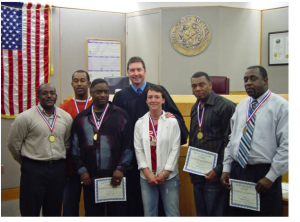12/10/12
A recent article in the Evansville Courier Press impressed me with its description of the Vanderburgh Superior Court, Judges Wayne Trockman and David Kiely and their Reentry court programs, which will receive nearly $1 million in grants and state reimbursements that will allow it to nearly double in size.
Of special note are the Re-Entry and Forensic Courts. “The Re-Entry Court works with the Indiana Department of Correction to allow felony offenders to serve 9 to 12 months of their sentence in segregated treatment at state prisons and then return to the county in a supervised continuation of their treatment program followed by a period of drug and alcohol probation. It is this Re-Entry Court program for which Vanderburgh County is now receiving reimbursements. Similarly, the Forensic Diversion Court allows people convicted and sentenced on lesser felony charges to participate in a court-supervised program rather than serve prison time.”
Both programs appear to rely heavily on what could be described as a Front-End Reentry Court Model, as they allow offenders, who otherwise would be facing long prison sentences, to spend less than a year in custody before returning to locally supervised treatment and rehabilitation programs. They are an important example of how Indiana Courts, are taking the lead in developing innovative reentry court programs (see article on Judge John Surbeck and the Allen County, Indiana Reentry Court)


